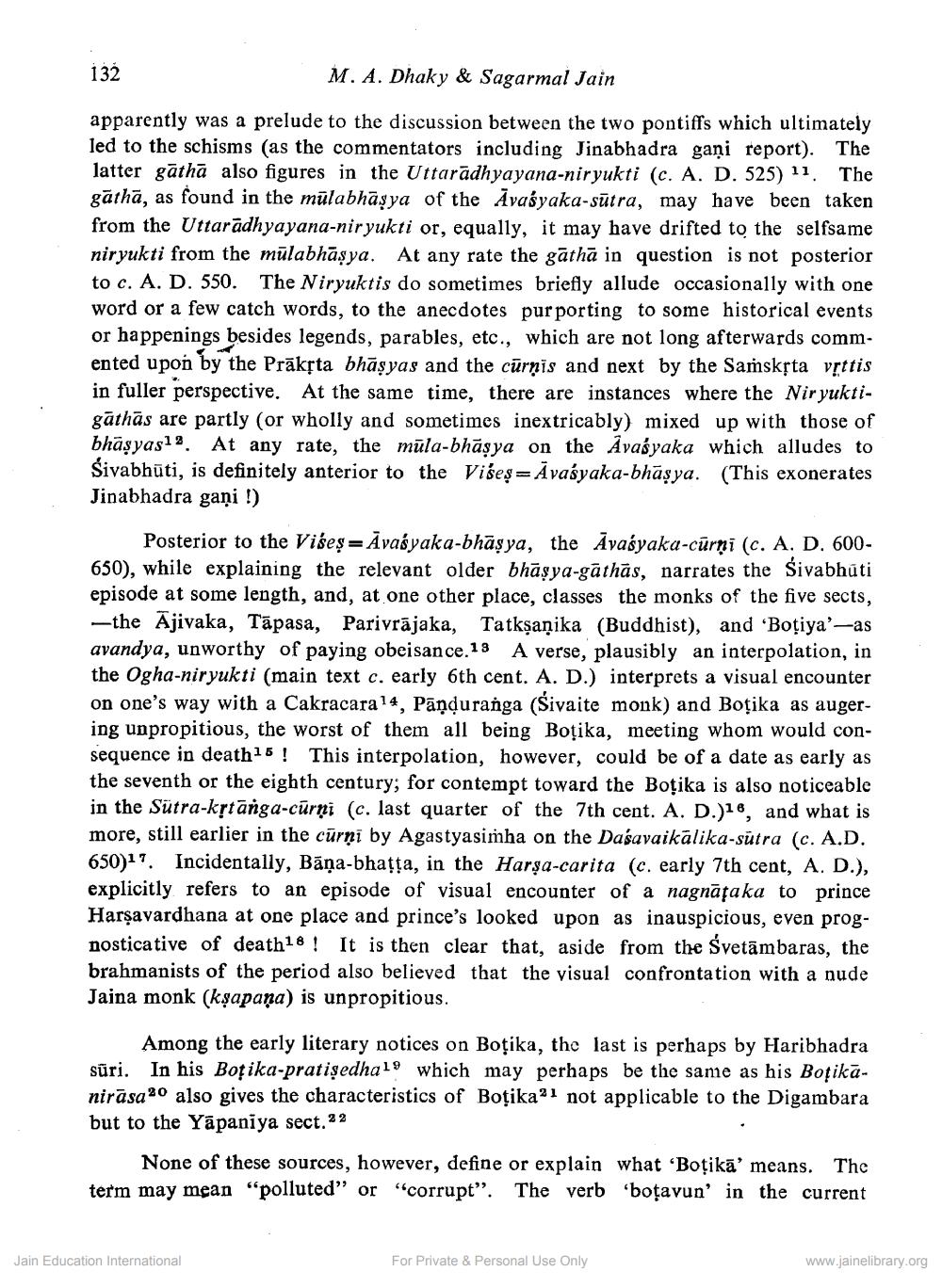Book Title: Propos of the Botika Sect Author(s): M A Dhaky, Sagarmal Jain Publisher: Z_Aspect_of_Jainology_Part_3_Pundit_Dalsukh_Malvaniya_012017.pdf View full book textPage 2
________________ 132 M. A. Dhaky & Sagarmal Jain apparently was a prelude to the discussion between the two pontiffs which ultimately led to the schisms (as the commentators including Jinabhadra gaṇi report). The latter gāthā also figures in the Uttarādhyayana-niryukti (c. A. D. 525) 11. The gāthā, as found in the mūlabhāşya of the Avaśyaka-sūtra, may have been taken from the Uttaradhyayana-nir yukti or, equally, it may have drifted to the selfsame niryukti from the mūlabhāşya. At any rate the gātha in question is not posterior to c. A. D. 550. The Niryuktis do sometimes briefly allude occasionally with one word or a few catch words, to the anecdotes pur porting to some historical events or happenings besides legends, parables, etc., which are not long afterwards commented upon by the Prāksta bhāsyas and the cūrnis and next by the Samsksta vșttis in fuller perspective. At the same time, there are instances where the Nir yuktigāthās are partly (or wholly and sometimes inextricably) mixed up with those of bhāşyas12. At any rate, the mūla-bhāsya on the Avašyaka which alludes to Sivabhūti, is definitely anterior to the Viseș= Āvasyaka-bhāşya. (This exonerates Jinabhadra gani !) Posterior to the Viseș= Āvasyaka-bhāşya, the Āvašyaka-cūrni (c. A. D. 600650), while explaining the relevant older bhāsya-gāthās, narrates the Šivabhūti episode at some length, and, at one other place, classes the monks of the five sects, -the Ajivaka, Tāpasa, Parivrājaka, Tatkşaņika (Buddhist), and 'Boţiya'-as avandya, unworthy of paying obeisance. 13 A verse, plausibly an interpolation, in the Ogha-niryukti (main text c. early 6th cent. A. D.) interprets a visual encounter on one's way with a Cakracara 14, Panduranga (Sivaite monk) and Boţika as augering uppropitious, the worst of them all being Boţika, meeting whom would consequence in death 15 ! This interpolation, however, could be of a date as early as the seventh or the eighth century; for contempt toward the Boţika is also noticeable in the Sütra-kṛtānga-curņi (c. last quarter of the 7th cent. A. D.)18, and what is more, still earlier in the cūrni by Agastyasimha on the Dasavaikālika-sutra (c. A.D. 650)17. Incidentally, Bāņa-bhatta, in the Harşa-carita (c. early 7th cent, A. D.), explicitly refers to an episode of visual encounter of a nagnāțaka to prince Harşavardhana at one place and prince's looked upon as inauspicious, even prognosticative of death18 ! It is then clear that, aside from the Svetāmbaras, the brahmanists of the period also believed that the visual confrontation with a nude Jaina monk (kşapana) is unpropitious. Among the early literary notices on Boţika, the last is perhaps by Haribhadra sūri. In his Boţika-pratiședhal' which may perhaps be the same as his Boţikānirāsa 20 also gives the characteristics of Boţika21 not applicable to the Digambara but to the Yāpaniya sect. 32 None of these sources, however, define or explain what 'Boţikā' means. The term may mean "polluted” or “corrupt". The verb 'boțavun' in the current Jain Education International For Private & Personal Use Only www.jainelibrary.orgPage Navigation
1 2 3 4 5 6 7 8 9
